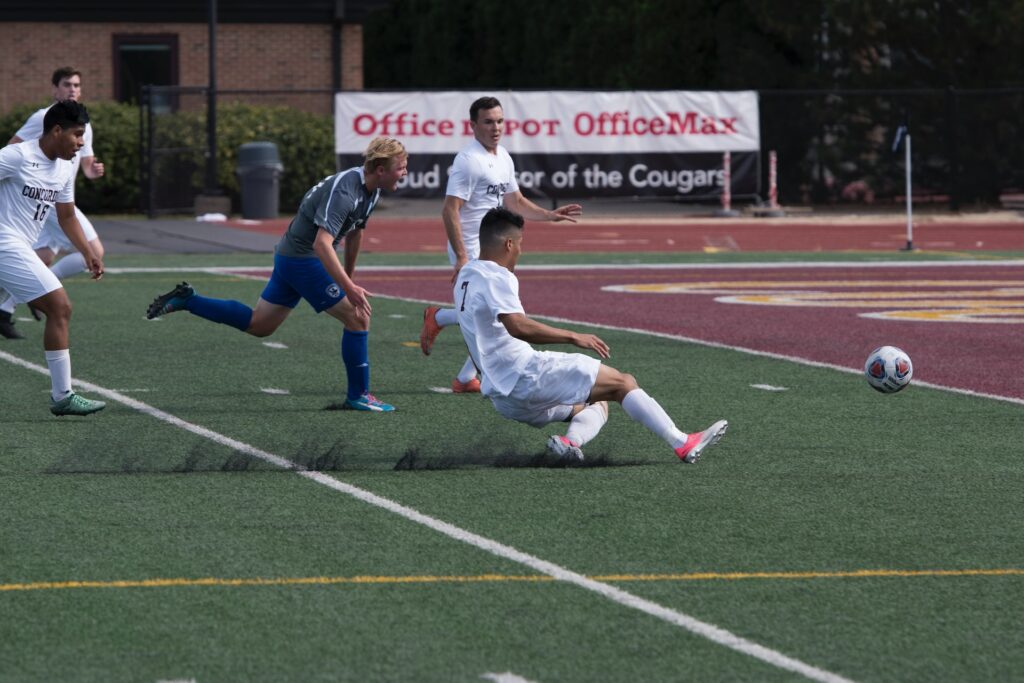Table of Contents
- So, what is catenaccio in soccer?
- Who pioneered catenaccio?
- Which formations work well with catenaccio in soccer?
- Is catenaccio negative?
- Is catenaccio good for underdogs?
- Examples of catenaccio in professional soccer
- Recap: Catenaccio in soccer
Many of the systems and formations that we see employed in soccer today can go back generations, even if soccer is a dynamic and evolving sport.
One such system is catenaccio, which entered the sport’s lexicon decades ago and still lingers to this day.
This article will look at what catenaccio is, how it is utilized, and some background on its historical use.
So, what is catenaccio in soccer?
Catenaccio is a tactical system that focuses on defensive structure through players dropping deep to assist others when out of possession. It relies on covering the position of others to quell the threat of the opposition then launching counter-attacks.
Catenaccio is an Italian word that loosely translates to bolt chain, referring to the bolt and chain on a door.
The premise of the idea is defensive cover through positionally shifting individuals so that they can help out defensively and get involved in any counter-attacks.
Who pioneered catenaccio?

Austrian head coach Karl Rappan is often credited with inventing catenaccio during his time at Swiss club Servette in the 1930s.
Rappan felt that his semi-professional side, who were regularly facing full-time professionals, lacked the quality and fitness that his opponents did and sought a way to bridge this gap.
Back in those days, teams often lined up with two defenders, three midfielders, and five attackers. However, when catenaccio was introduced, it converted two of those midfielders into wide defenders (full-backs), and turned two or three attackers into midfielders.
A lot of the idea was to overwhelm the attacking numbers that the opposition sent forward. Rather than the fewer defensive players assigned to quell this threat, the original two defenders now had help on the flanks, meaning they would outnumber their counterparts, win the ball back when the opposition had committed men forward, then launch a counter-attack to expose their vulnerability.
The now-renowned system that delivered success and went on to be borrowed from managers across international borders.
Which formations work well with catenaccio in soccer?
A 5-3-2 formation can work effectively with the catenaccio approach.
Inverted full-backs are preferred by many head coaches in this system because it affords you the luxury of moving them up or down the flanks depending on what’s required.
When leaving these gaps as full-backs creep forward, the areas can be covered by the wider central defenders forming the back 5. The most central defender, referred to as the ‘bolt’ in catenaccio because they remain in their original position, remains the constant throughout, staying central to cover for his defensive partners.
If you decide to employ a 4-3-3 formation when using catenaccio, the central defenders will each edge towards their closest flank to cover full-backs when the opposition threatens down that side. The center-half who’s further away from the action then acts as the bolt to keep the system formed.
Because catenaccio revolves around players dropping deeper, many believe that legendary players like Franz Beckenbauer were ideal for the system because of his famed ability to mop up as a sweeper then drive forward to contribute to attacking moves. You can read more about the iconic German in our recent article.
Is catenaccio negative?
The catenaccio system is considered a defensive one which many would classify as negative.
From its origins, the system was created to nullify technically superior opponents when your side will likely have difficulty containing them.
Counter-attacks are a big part of the system with direct passes being a heavy feature. This means that possession-based soccer isn’t a strong theme in catenaccio so the modern manager might deem this as negative.
That doesn’t make it right or wrong, of course. It’s often illogical to be an all-out attack team when facing strong opponents. Whatever works to win the match can be viewed as successful, whether some see it as negative or otherwise.
There are many ways and formations to line up with when employing the catenaccio system, as numerous Swiss managers creatively experimented the 1940s and 1950s in Italy, making it perhaps more versatile than many believe.
Despite its malleability, there’s no disputing that the system is centered around defensive work to soak up opposition pressure and it would be a stretch to call the system attacking in most senses.
Is catenaccio good for underdogs?
Yes, catenaccio could work well for underdogs in a game.
The chances are that your opposition will have the majority of the ball anyway if they’re technically and physically superior, so you don’t need to worry about sacrificing possession.
Doubling up on each attacking player means you have a greater chance of nullifying their attacks. Winning the ball when their players are advanced gives you the opportunity to counter-attack, which could be a rare foray forward in the game for your team.
Learn more about the best tactical approaches for weak teams in this recent article.
Examples of catenaccio in professional soccer
Perhaps the best example of the system throughout history is from the 1960s, when Internazionale won two European Cups and lost another final while adhering to catenaccio.
When Helenio Herrera’s attacking methods weren’t bearing any fruit to begin his tenure at Inter, the legendary Nerazzuri manager decided to go back to basics. Direct passing, not the slow and methodical build-ups we see today, was what he wanted.
Inter went on to dominate Serie A and European soccer alike, proving defensive structure can bring about success.
One of the more modern advocates of the catenaccio system is Italian head coach Antonio Conte, who successfully used the system during his time in charge of Chelsea.
The Blues focused on working hard off the ball to help teammates, converting a 3-5-2 into a 5-3-2 when defending, and winning the ball back to break before giving the opposition a sniff at a chance.
Recap: Catenaccio in soccer
We can sometimes be guilty of believing that tiki-taka and progressive soccer is the only way to play, a testament to Pep Guardiola’s genius and influence on the European game.
Yet there’s no shame in admitting that your side will need to set up defensively to combat the threat your skilled opponents possess.
The catenaccio approach has stood the test of time yet evolved as the game has changed, thanks to the thoughtful tinkering of some of the world’s most shrewd and innovative soccer coaches.

